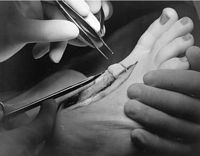


The development of microvascular surgery in Australia
Introduction
Participants
Beginnings
Developing links with academia and hospital medicine
A bevy of supporters
An ever-widening circle of contributors
Building research capacity
Nurturing relationships
Raising funds for research and development
The microsurgeon and the law
Winning community and corporate support
Leadership
The Institute and its style
Endnotes
Index
Search
Help
Contact us

My PhD project was on ischaemia reperfusion injury which Wayne has spoken about already. At the same time I was involved in research projects looking at prefabrication of flaps, knee joint transplantation, all sorts of broad things. So we really did need a handle on all sorts of research issues which gave us a broad background and knowledge of things. This made us a little unusual compared to other scientists in that we were not so focused on one issue.
I'll finish by concurring with Sue about her memories of Mr O’Brien. It always amazed me how he could remember so much. You’d think, 'He won’t remember that I was supposed to be doing that.’ But he never forgot a single thing and I was always amazed at his capacity for that sort of thing.
Ken Knight: One other feature of Bernie's approach. He was a great stickler for perfection in papers. I think he’s the only person I’ve ever known that you had to go through ten drafts of any one paper before it was in the right form to send off to a journal. He certainly had great attention to detail and you could absolutely guarantee that if you were discussing the twenty-third page of the fifth draft he’d pick it up on the green card. That was where you’d continue the next conversation.
Ann Westmore: It's very noticeable in the annual reports of the late 1980s that he starts to say that the scientific side, the research side, is moving into new territory. It’s as if there’s a real injection of energy into that side of things that leads him to speak in very positive ways. Is this indicative of a John Hurley and a Jim Angus influence?
Laurie Muir: It was a move to take it beyond the hand, wasn't it? A move to get out into all the tissue issues.

The Institute took a strategic decision to move beyond the hand in the mid- to late-1980s. Used with the permission of the Bernard O’Brien Institute of Microsurgery.
Wayne Morrison: Yes, I think it was. Microsurgery was the basis for doing many new things that moved beyond the traditional plastic surgery repertoire. It really allowed you to think creatively in terms of being able to take tissues from any part of the body and use them to match what was missing. So it really allowed you to apply art as well as science, and that's what’s been attractive, I think, to many of us.
As regards the new developments, Michael mentioned prefabrication, which was really the further development of your ability to design a piece of tissue to be more appropriate to what you're trying to reconstruct. We were certainly world leaders at that time and our publications attest to that clinically.[70] In those days, you could experiment on humans more easily than animals. We had some spectacular cases of what was called prefabrication of implanting a blood vessel into the right layer of the skin, so now you create a new design in a sense that allows you then to transplant that tissue subsequently to another site based on the blood vessel that you transplanted. So that in itself generated a new area of research because this was what’s now known as angiogenesis, or new blood vessel formation, and to us that was pretty exciting.[71]
The thing I found exciting about this whole enterprise was that microsurgery was a microcosm of the big picture. What we were doing parallels what the big research centres [were doing]. Angiogenesis is all to do with, firstly, embryology which is now all stem cell research. Angiogenesis is that process that happens after a heart attack or stroke where the body tries to regenerate a new blood vessel after the vessel has blocked. So here we are doing similar research to what Jim has mentioned [involving] pharmacology and coronary artery disease. We're all in the same game. So you realise this has a lot of application beyond the minor area of microsurgery.
On the one hand, you feel rather inferior because [you think], 'Hang on, we can't be competitive with these people who are out there’. And yet it makes it such a broad area of interest, it made us become competitive. We realised that previously we were puddling around in relatively soft science. Now we have to be competitive. That’s been very gratifying in recent years. In fact, we obtained the highest NHMRC grant for Melbourne University.[72] We’re obviously competitive with every other research institute in Victoria. So it’s rewarding that we have, in a sense, come to that level where we can be seen as not just a boutique area which we capitalised on in the early years and benefited from. Now we’re out in the big ocean, swimming around. It’s more threatening but it’s actually more exciting because our credibility is up there. But big challenges are still coming.
 |
Witness to the History of Australian Medicine |  |
© The University of Melbourne 2005-16
Published by eScholarship Research Centre, using the Web Academic Resource Publisher
http://witness.esrc.unimelb.edu.au/056.html